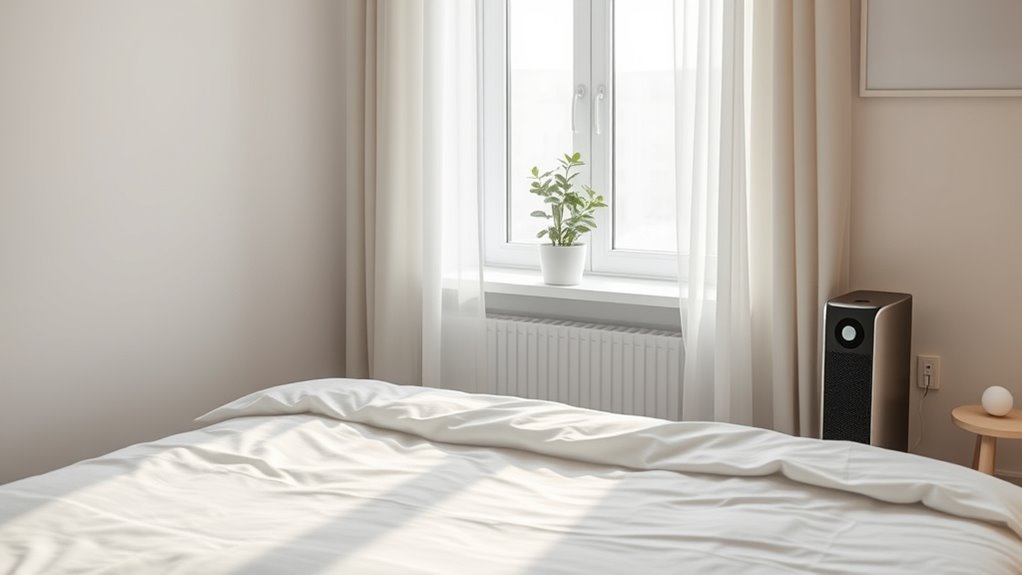To reduce allergens in your bedroom, use a HEPA air purifier to eliminate airborne particles like dust, pet dander, and pollen. Encase your mattress with an allergen-proof cover to block dust mites and other pests. Keep your room clean by washing bedding weekly in hot water and vacuuming regularly with a HEPA-filter vacuum. Controlling humidity and ensuring good ventilation also help. Keep exploring to discover even more simple ways to create a healthier sleeping environment.
Key Takeaways
- Use HEPA air purifiers to remove airborne dust, pollen, pet dander, and mold spores effectively.
- Encase mattresses with allergen-proof covers to block dust mites and reduce allergen buildup.
- Wash bedding weekly in hot water and vacuum with a HEPA-filter vacuum cleaner regularly.
- Maintain low humidity levels and ensure proper ventilation to inhibit mold growth.
- Keep the bedroom clean and dust-free by regularly cleaning surfaces and minimizing clutter.

Your bedroom should be a haven for restful sleep, but allergens like dust mites, pet dander, and mold can disrupt that peace. To create a healthier sleep environment, you need effective strategies to reduce these allergens. One of the most beneficial steps you can take is using an air purifier. Air purifier benefits are vital because they help remove airborne particles that trigger allergies. High-efficiency models with HEPA filters capture dust, pollen, pet dander, and mold spores, improving indoor air quality. When you run an air purifier regularly, you’ll likely notice fewer allergy symptoms like sneezing, congestion, and itchy eyes, making it easier to breathe deeply and sleep soundly.
In addition to purifying the air, protecting your mattress is essential. Dust mites, which thrive in bedding, are a major source of allergic reactions. Mattress allergy covers are specially designed to create a barrier that keeps these microscopic pests out of your bed. These covers are tightly woven and encase your mattress completely, preventing dust mites from burrowing into mattresses and bedding. Using mattress allergy covers is a simple, effective way to reduce allergen buildup over time. They also help contain existing allergens, making cleaning easier and more effective. When combined with washing your sheets weekly in hot water, mattress allergy covers considerably cut down on dust mite populations, leading to a cleaner, healthier sleeping environment.
Creating a thorough allergen reduction plan means investing in both an air purifier and mattress allergy covers. The air purifier benefits extend beyond just removing airborne allergens; it also improves overall indoor air quality, reducing mold spores and pet dander that often linger in the air. Meanwhile, mattress allergy covers target the allergens that hide deep within your bedding, preventing them from becoming airborne again. Both strategies work together to minimize your exposure, especially if you have allergies or asthma.
Additionally, understanding the importance of industry transformations like AI automation can help you stay informed about innovations that might improve allergy management or home comfort solutions in the future.
To maximize these benefits, keep your bedroom clean and well-ventilated. Wash bedding frequently, vacuum with a HEPA-filter vacuum cleaner, and maintain low humidity levels to inhibit mold growth. By taking these steps, you’re actively reducing the allergens that disturb your sleep. Incorporating an air purifier and mattress allergy covers into your routine isn’t just about convenience; it’s about reclaiming restful nights and breathing easier every day. With consistent effort, you’ll notice your allergy symptoms diminish, and your bedroom will truly become a sanctuary for quality sleep.
Frequently Asked Questions
What Are the Most Common Bedroom Allergens?
The most common bedroom allergens are dust mites and pet dander. Dust mites thrive in bedding, pillows, and mattresses, triggering allergies when disturbed. Pet dander from cats and dogs lingers in the air and on surfaces, causing sneezing and congestion. To reduce these allergens, wash bedding regularly, use allergen-proof covers, keep pets out of the bedroom, and vacuum frequently. These steps help create a healthier, allergy-friendly sleeping environment.
How Often Should I Clean My Bedding?
You should wash your bedding at least once a week to maintain mattress cleaning and pillow hygiene. This helps remove dust mites, allergens, and skin flakes that accumulate over time. Use hot water when possible, as it’s more effective at killing germs and allergens. Additionally, regularly vacuum and air out your mattress and pillows to keep your sleeping environment fresh and allergen-free, improving your overall sleep quality.
Can Indoor Plants Help Reduce Allergens?
Indoor plants can help reduce allergens by acting as natural air filters, improving air quality in your bedroom. To maximize their benefits, you need proper plant maintenance, including regular watering and cleaning to prevent mold and pests. Choose plants like snake plants or peace lilies, which are especially effective at filtering airborne allergens. Incorporating these plants creates a healthier environment, making it easier to breathe and sleep better.
Are Air Purifiers Effective Against Bedroom Allergens?
Air purifiers are effective against bedroom allergens if you choose the right device and maintain it properly. You should select a model with a HEPA filter, which captures tiny particles like dust mites and pet dander. Regular air purifier maintenance, such as changing filters as recommended, guarantees peak performance. By doing so, you’ll breathe cleaner air, reduce allergy symptoms, and create a healthier sleeping environment.
What Hypoallergenic Materials Are Best for Bedding?
A stitch in time saves nine, and choosing hypoallergenic fabrics for your bedding is a smart move. You should opt for allergy-friendly bedding made from tightly woven fabrics like tightly woven cotton or silk, which prevent dust mites and allergens from settling. Hypoallergenic materials such as bamboo or microfiber are also excellent choices, helping you breathe easier and sleep better while reducing allergen exposure in your bedroom.
Conclusion
By following these simple tips, you can turn your bedroom into a allergen-free sanctuary. Think of it like cleaning a mirror—you’ll see a clearer, healthier space once you remove dust and allergens. Regular cleaning, washing bedding, and keeping humidity in check make a big difference. With a little effort, your bedroom will become a cozy oasis where allergies don’t stand a chance, and you can breathe freely like a gentle breeze on a spring day.









